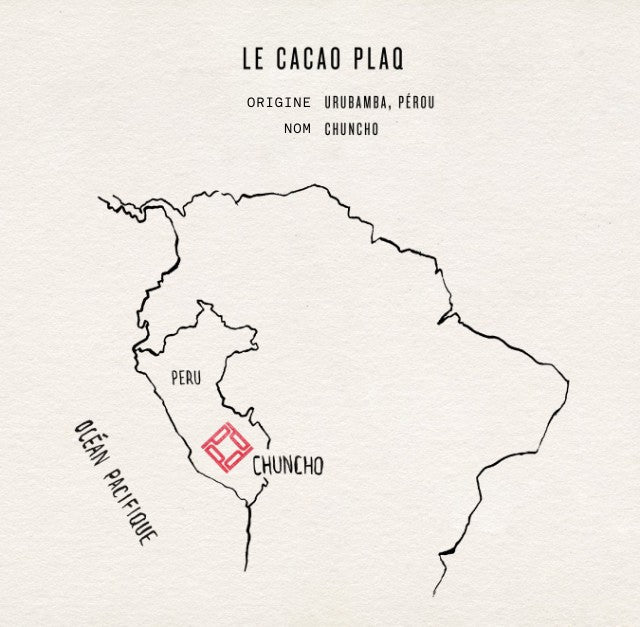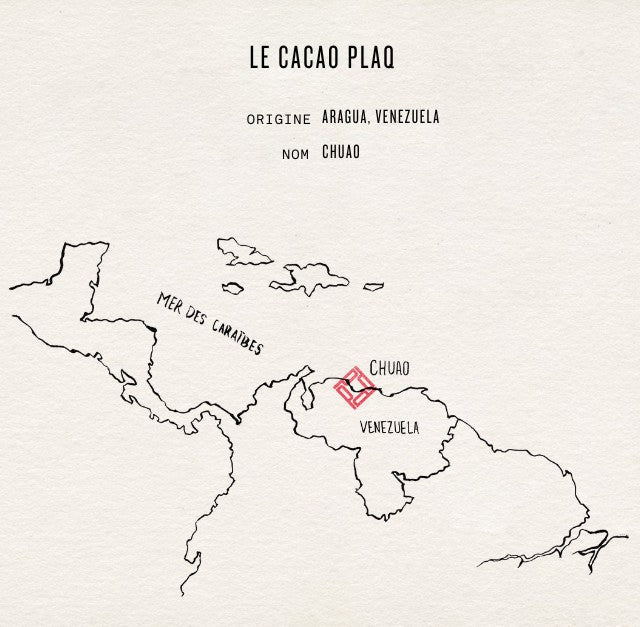CHLOÉ, FOR YOU, WHAT IS CULTURE, THE BEAN TO BAR METHOD?
Bean-to-bar, a new chocolate manufacturing philosophy, born in the 2000s in the USA. It is a return to the purity, to the simplicity of chocolate. Like in the last century, just cocoa and sugar.
But a great cocoa, a cocoa with a history, an ethic, a beautiful aromatic palette and just enough sugar to let its aromas bloom. It's taking the time to do it, the time to understand every detail of the transformation, the alchemy of the transformation from the cocoa bean to the bar. It's a work of goldsmith. It means working with high quality beans and producing small volumes. Nothing is left to chance to create very high quality chocolate. This is THE priority of the Bean to Bar method, our obsession!
The Bean to Bar method combines the best of the last century and the best of modern times to create a completely different style of chocolate. A great chocolate. It’s a chocolate renaissance. A renaissance that evolves and improves all the links in the chain from producer to consumer : the genetics of the plantations, post-harvest work, the diversity and quality of cocoa on the market, the price of cocoa, the price of the bar... and the consumer's palate.

WHAT ARE THE SPECIFIC FEATURES OF BEAN-TO-BAR CULTURE?
In the Bean to Bar culture, we seek values of traceability and transparency. We talk more about cocoa, the producer and the know-how of the manufacturer. A bit like the Japanese who pay tribute to their ingredients and Master Craftsmen.
WHAT DIFFERENTIATES BEAN-TO-BAR CULTURE FROM OTHER CHOCOLATE CULTURES?
The biggest difference is in the quality of the bean. For great chocolate, you need great cocoa. The Bean-to-Bar culture seeks to reveal the cocoa bean, to let its personality blossom, we take the time to look for the right bean before “producing-to-sell”.
We sort the beans, to select only the best. Then, we accompany them, we watch them, we taste them, we listen to them. We no longer want to hide the beans, but we want to reveal them. Reveal their delicate, complex sides…and we roast them gently.
We tried to hide the taste of the bean for years, to mask the defects of poor quality beans. We also age the blocks of chocolate like a fine wine to perfect the aromas. And it is only when the chocolate is melted to temper it that the different chocolate professions come together. Here only begins that of the chocolate confectioner.

HOW IS THE BEAN-TO-BAR CULTURE ORGANIZED?
At its core, Bean-to-Bar is a generous philosophy. The creators of the Bean-to-Bar brands wish they could do it all! Go see the producers, work hand in hand with them and make the chocolate. But they quickly realize that they have neither the time nor the money. When we know that it takes around 5 days of work to make 60 kg of beans for a Bean-to-Bar brand versus 1 day of work to make 500 kg for the big chocolate brands, that leaves little time to do everything else.
New professions then appeared and Bean-to-Bar brands work with online sourcers or traders who share their values of ethics, transparency and quality.
WHAT ARE THESE NEW PROFESSIONS?
Specialty cocoa traders-sourcers for example. They know Bean-to-Bar brands and their needs. They work with the producers from whom they buy freshly harvested cocoa to manage the rigor of fermentation and drying themselves, essential steps for a quality bean. Because unfortunately many producers know how to produce but do not seek to produce quality. And paying them more to work better does not change their way of working or living, unfortunately. So the specialty cocoa traders-sourcers took over just after the harvest.
The major traditional chocolate brands obtain their supplies from major traditional traders, often through catalogues. In the new professions, there are also the new specialized Bean-to-Bar stores, especially in the USA, Bean-to-Bar chocolate festivals in producing countries, and cocoa and chocolate competitions.
WHAT IS YOUR ROLE WITH THE BEAN-TO-BAR ACTORS?
I have many. I started by educating consumers . My first chocolate tasting classes date back to 1997! And I continue to introduce the different qualities and styles of chocolate around the world. I do coaching for brands, strategy consulting, product development, staff training.
I also select cocoa beans for brands. I support producers to integrate the notion of quality during all stages of production and I analyze the different qualities of cocoa and chocolate for producers, traders and manufacturers of quality chocolate. I am known for my outspokenness and the uprightness of my values. I'm a bit of a safeguard, I make a lot of reminders about ethics.

WHAT ARE THE POINTS FOR IMPROVEMENT REGARDING THE BEAN TO BAR CULTURE?
Bean-to-Bar has exploded around the world! There is therefore also fraud and lies among certain brands. We need foundations and associations, so that from producers to consumers, we educate and regulate marketing “the art of selling” but also to help people and their palates to recognize chocolates, the good ones. Education, information and collaboration are the keys to growing the Bean to Bar movement. Above all, we must show by example, I think. Because the anti-fraud system generally doesn't work. Upstream, in cocoa plantations, quality and transparency must also be improved: harvest healthy and ripe fruits, optimize the development of aromatic quality in the fermentation and drying stages, sort the cocoa before sending to chocolate manufacturers, ensure the traceability of each bag, and stimulate collaboration between Bean-to-Bar players. Everyone will win.
DO TRADITIONAL CHOCOLATE BRANDS FEEL CONCERNED BY BEAN-TO-BAR CULTURE?
There are two types of brands: those that make their chocolate from cocoa and those that buy chocolate ready to melt (the vast majority).
In Europe, these brands were very slow to accept that this movement was not just an insignificant little fad but an important international trend. This trend is redefining not only consumer choices but also the diversity and price of cocoa that manufacturers buy.
Many chocolate confectioners are starting to have a guilty conscience about their ways of doing things and are equipping themselves with equipment to make Bean-to-Bar chocolate. So yes, brands are aware that there is a market and want to change or create new ranges. It’s a pivotal time for chocolate !

WHAT IS THE PLACE OF WOMEN IN COCOA CULTURE?
On the American continent, it is women who are mainly on cocoa plantations. Men do the heavy lifting. Overall the distribution is quite well done across the entire chain, 50/50, but it is mainly women who speak out about chocolate.
WHAT STRONG ACTION CAN WE DO TODAY TO SUPPORT THE DEVELOPMENT OF BEAN-TO-BAR?
The future of BTB is in the hands of the consumer! In their ability to perceive with their palates, how different this type of chocolate is. Understanding the philosophy, perceiving the quality and buying these chocolates means supporting this movement, increasing the chances of living new, grandiose sensory experiences in the future. Educate yourself to trust your palate, but also check what brands say, force them to be transparent and obvious.
Because be careful, Bean-To-Bar is not synonymous with quality for all brands. It is also up to the consumer to recognize the good ones, and through the act of purchasing (or not purchasing) to support only the best. Like great wines, cheeses, olive oils, and many other gourmet products, they are more expensive and take longer to produce, and much more interesting, complex, intense and long in the mouth than other chocolates...therefore more expensive .
It is the consumer who has the power to make change happen. The market must continue to flourish, people must educate themselves and brands must be more transparent. The opportunities to do well are there! It is a chance.
IF THE PHILOSOPHY OF BEAN-TO-BAR CULTURE WAS ONE WORD?
1 word would be impossible, but if necessary I would say: quality. A sublime chocolate that transports you, an absolutely delicious chocolate.
WHY SHOULD WE FOCUS ON BEAN-TO-BAR CULTURE?
For a better world, to improve the standard of living of producers, to stimulate diversity and for the greatest pleasure of us all!

























